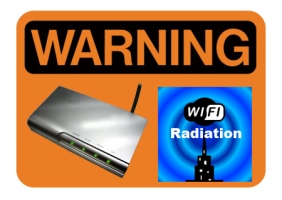Wi-Fi Radiation Induces “Diabetic-Like Status” in Rats
 In a recent study published in the journal ofEnvironmental Toxicology and Pharmacology[1], an investigation was performed to study the effects of exposing rats to radiofrequency (RF) radiation from Wi-Fi devices and to further study the possible protective role of administering an olive leaf extract to reduce the damage in liver and kidney cells of the exposed rats.
In a recent study published in the journal ofEnvironmental Toxicology and Pharmacology[1], an investigation was performed to study the effects of exposing rats to radiofrequency (RF) radiation from Wi-Fi devices and to further study the possible protective role of administering an olive leaf extract to reduce the damage in liver and kidney cells of the exposed rats.
According to the article, there has been “considerable interest in finding natural antioxidants from plant materials in order to repair several diseases caused by endogenous or environmental factors such as artificial EMF.” It was further stated that olive leaf extracts have been shown to have “anti-oxidative” properties.
As a part of the study, rats were exposed to RF radiation from Wi-Fi devices broadcasting with a signal at 2.45 GHz. Rats were exposed for only one (1) hour per day for a total of 21 consecutive days. This type of exposure was referred to as “sub-chronic.” Control rats were tested under the same conditions but there were no RF emissions from the Wi-Fi devices.
A principal finding of the study was that “RF exposure induced a diabetes-like status through alteration of oxidative response” and that “RF exposure could decrease body weight between the first and the last day.” In addition, it was found that administration of the “olive leaves extract was able to correct glucose metabolism disorder by minimizing oxidative stress induced by RF in rat tissues.”
Here is another selected quotation from the published article:
“Indeed, RF radiation induced glucose metabolism disorders. … The disorders in glucose metabolic could be explained by alteration in function, structure, and/or secretion of insulin after RF exposure. … Furthermore, RF radiation could affect the glucose uptake by peripheral tissues.”
In the figure shown below, slide A shows normal liver cells with “well preserved cytoplasm, nucleus, nucleolus.” However, in the case of RF exposed rats, slide B shows liver cells that “were hypertrophied with clear cytoplasm” and that “have a vegetal cell shape, the enclaves were optically empty represent[ing] the steatosis [fatty cells] which defined hepatic lesions.”

The results summarized above appear quite stunning, and the implications are clear; RF radiation induces adverse biological effects upon cell structures and the functioning of those cells. Use of antioxidant agents, in this case olive leaf extracts, may be able to provide a protective role against damage caused by RF radiation exposure.
The “highlights” of the published article as summarized at the ScienceDirect website are:
- The exposition to the radio frequencies (2.45 GHz) induced metabolic disorders.
- The exposition to the radio frequencies (2.45 GHz) induced a diabetic-like status.
- The exposition to the radio frequencies (2.45 GHz) induced oxidative stress.
- Olive leaves extract prevented against metabolic alterations.
- Olive leaves extract enhanced antioxidant responses.
[1] “Effects of Olive Leave Extract on Metabolic Disorders and Oxidative Stress Induced by 2.45GHz WIFI Signals,” by Salah, et. al., Environmental Toxicology and Pharmacology, Volume 36, Issue 3, November 2013, pages 826–834.
No comments:
Post a Comment